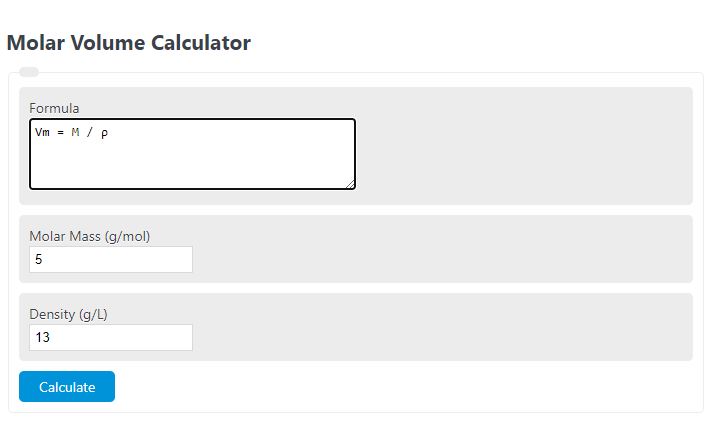Enter the molar mass and the mass density into the calculator to determine the molar volume.
Molar Volume Formula
The following formula is used to calculate a molar volume.
Vm = M / ρ
- Where VM is the molar volume (L/mol)
- M is the molar mass (g/mol)
- ρ is the mass density (g/L)
To calculate the molar volume, divide the molar mass by the mass density.
Molar Volume Definition
A molar volume is defined as the total liters of total volume occupied per mole of a substance.
Molar Volume Example
How to calculate molar volume?
- First, determine the molar mass.
The molar mass is the number of grams per mole of a substance. For this example, we will say this is 20 g/mol.
- Next, determine the density.
For this example we will say the density is 5 g/L.
- Finally, calculate the molar volume.
The molar volume is 20/5 = 4 L/mol
FAQ
What factors can affect the molar volume of a substance?
Molar volume can be influenced by temperature and pressure. As these conditions change, the volume occupied by a mole of substance can increase or decrease due to the expansion or compression of the substance.
How is the molar volume related to the ideal gas law?
The molar volume of an ideal gas at standard temperature and pressure (STP) is directly related to the ideal gas law. According to this law, one mole of any ideal gas occupies a volume of 22.4 liters at STP. This relationship is a practical application of the molar volume concept in understanding gas behaviors.
Can molar volume be used for both solids and liquids?
Yes, while molar volume is often associated with gases, especially in the context of the ideal gas law, it can also be applied to solids and liquids. The concept remains the same: it is the volume occupied by one mole of a substance. However, the values and their sensitivity to temperature and pressure changes can vary significantly between states of matter.

